BLOOD OF THE BEASTS Matthew Lax on P. Staff at Kunsthalle Basel
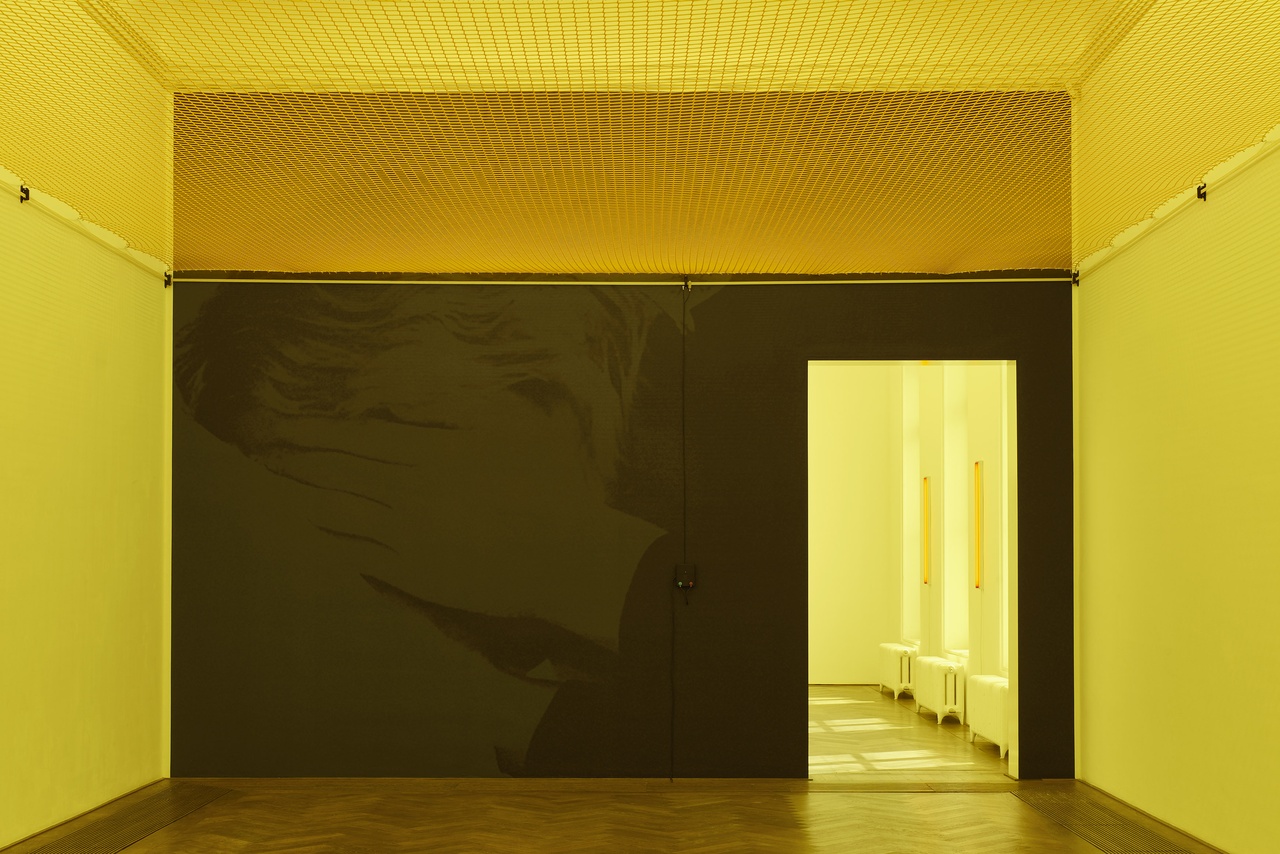
“P. Staff: In Ekstase,” Kunsthalle Basel, 2023, installation view
“It’s for your own safety,” I can imagine someone saying. The room is charged, bathed in acrid yellow light. Above, a giant electrified net, Afferent Nerves (2023), is suspended, waiting, the control system blinking ominously. Removed from the agrarian milieu, there is still a sense of impending danger, of waiting for the other shoe, or the proverbial anvil of slapstick, to drop. The thing is on, but out of reach.
- Staff’s exhibition “In Ekstase,” on view at Kunsthalle Basel, sustains a kind of edgeplay in an interrogation of power, transness, and personal agency. Safety depends on who wields the tool; release, whether corporeal freedom or out-of-body ecstasy, is contingent on the keyholder. Afferent Nerves is a trap.
The Kunsthalle’s first-floor exhibition space is a series of rooms, one after another, which forces a particular experience, much like the sequential chapters of a novel. One cannot access the film La Nuite Américaine, which is located in the final room and would otherwise be the centerpiece of the show, without allowing oneself to be herded, rounded up, and escorted there, and at the film’s completion, looped back through the show to the lobby.
The second room, soaked still in the same jaundiced pallor, offers an arrangement of utilitarian objects on the mirrored surface of a black pedestal: an electrical outlet, a window latch, doorknobs, floor molding and individual floorboards, light switches – all replicas of the actual Kunsthalle’s fixtures. Titled Bloodheads (Kunsthalle Basel), the albumen-based biopolymer casts, made in collaboration with artist-designer Basse Stittgen, are made from animal blood, the refuse of the slaughterhouse. These elements reappear in situ throughout the space, their actual function made clear, suggesting the architecture might disintegrate at first use, House of Wax-style, melting and carrying museumgoers away in a torrent of bodily fluids.
If this is a question of consumption, and as some of these artworks imply, some of us are animals, what is the species? In Georges Franju’s 1949 short, black-and-white documentary Le Sang des bêtes (Blood of the Beasts), a horrific account of a French abattoir, the director cuts from close-ups of cows getting cut open to serene wide shots of children playing in the Parisian suburbs. The sins of the slaughterhouse, for all its cruelty, are framed within an economy that washes away the sins of murder. The butcher feeds his city. The city runs on meat. The beasts must be killed.
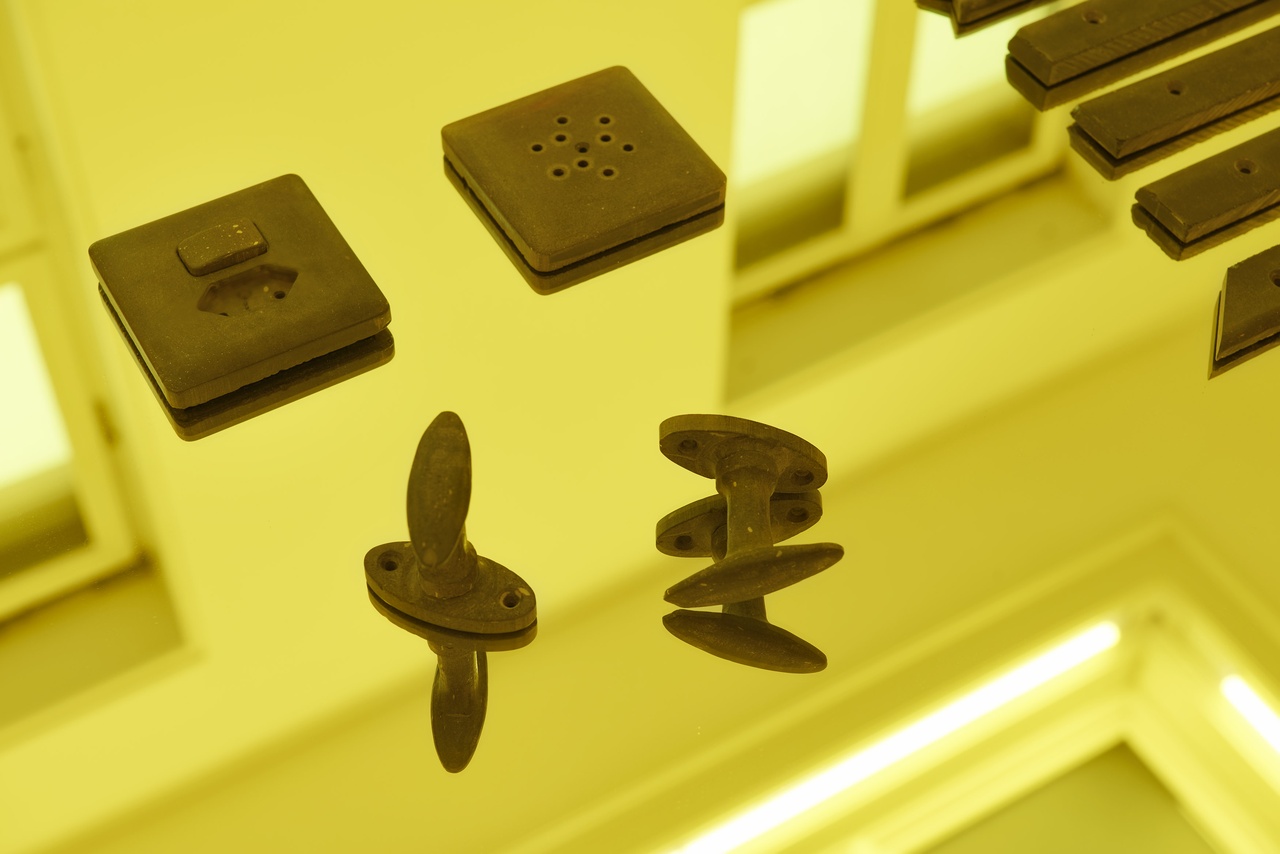
P. Staff in collaboration with Basse Stittgen, “Bloodheads (Kunsthalle Basel),” 2023
Unlike documentary, which rarely escapes the horror of its own image, Staff’s sculptures conjure the same transformation process by way of abstraction, or again, withholding. Cuddle-ability, the cuteness of the animal, is an important aspect of cross-species identification, for empathy. In Franju’s film, one still feels sympathetic to the lost plight of each bleating sheep, stomping horse, and languid cow that passes before the lens, a connection made more painful when each reappears as their inert innards. Staff’s Bloodheads could be thought of as byproduct; the animals have lost specificity, neither mother nor custom can claim them their own, clean or uncouth, but they have again been reabsorbed and repackaged. If it weren’t for the materials listed, or the museum’s exhibition text, they might go unnoticed entirely. The animals’ life force, the so-called waste, is recycled, and their ashen, stained remains now the actual infrastructure of the otherwise pristine Kunsthalle building. Similar to the logic of Franju’s film, Bloodheads re-situates the institution within the economy it serves. The artist, still a beneficiary of this apparatus, implies that the Kunsthalle, and perhaps the entire culture-building machine, is still soaked in the blood of others, a veiled nod to the manufacturing and bioengineering history of Basel, as well as to a colonial violence, however subtle, by which a hegemonic culture is often created and maintained.
Staff’s Bloodheads collaborator Basse Stittgen’s other project, Blood Related (2017 – ongoing) produces objects, records and record players, dinner sets, and other strangely Bauhausian housewares made from pure cow blood, also acquired from slaughterhouse refuse. If we are what we eat, and these are objects of fabulist proportions, when does this cyclical act of manufacturing via animal become redundant?
The difference between Stittgen’s cow-blood record, which plays the sounds of a cow (think Robert Morris), and, say, glue made from the collagen of a horse, is intention. The origin of the horse glue is concealed; it was a historically cheap method to produce glue from an otherwise “throwaway” horse’s body, sold as raw material. The record, as with Bloodheads, is designed to draw attention to its source and the problems within the meat industry; it is Cow with the Sound of Its Own Undoing. This is what art is for, but what does it mean to repurpose or recycle the dead, or, though not directly perpetuating the violence, make use of the residual damage of carnage? Staff does not force parodic responsibility onto the natural world, there is no Animal Farm uprising, yet the analog between the methods used to corral and treat the innate and carnal desires of queer people and the treatment of animals reminds us that contemporary life is helplessly omnivorous. We are inevitably complicit, or at least involved. [1] The undead, repurposed Bloodheads cannot claim full animality; but just as their waste can be found in certain human blood thinners, bandages, gum, and deodorant, these everyday items are now just as much a part of us.
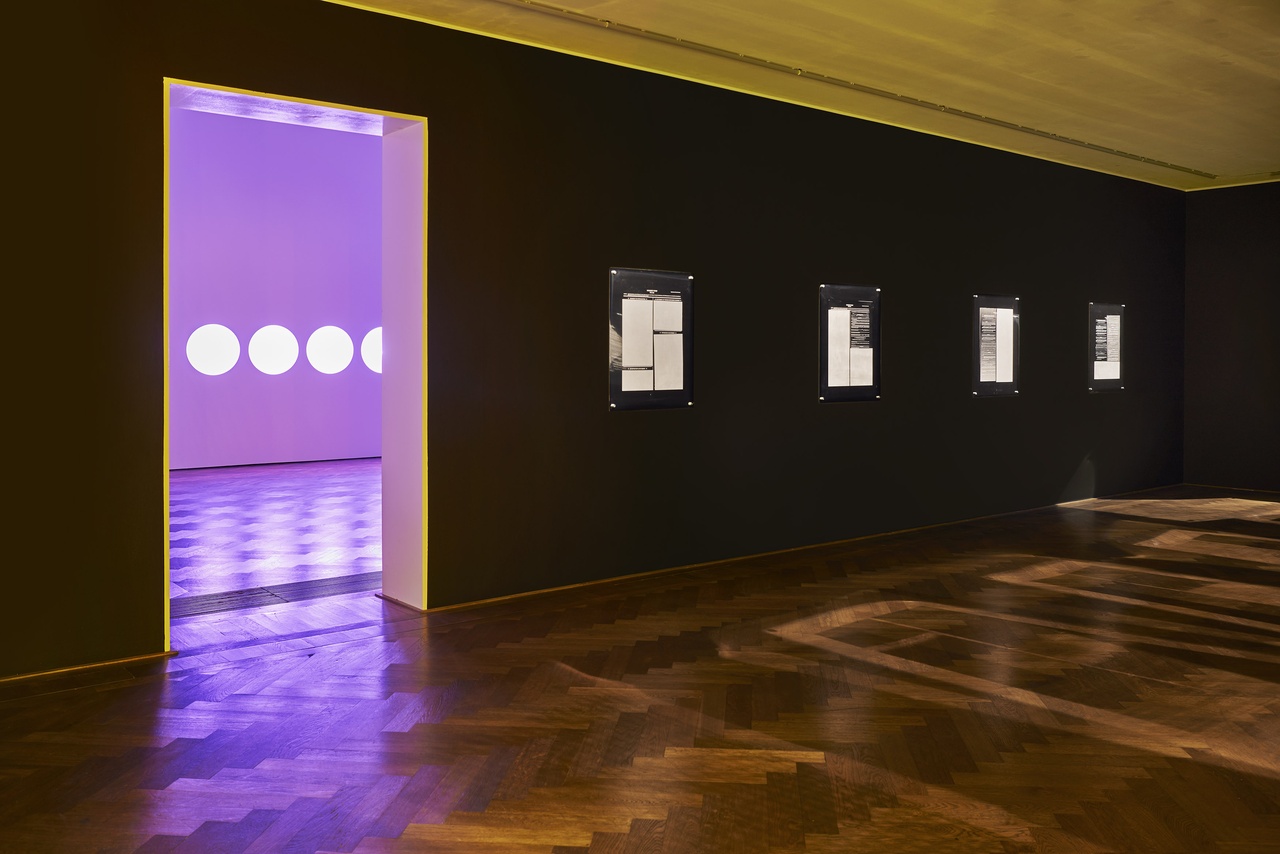
“P. Staff: In Ekstase,” Kunsthalle Basel, 2023, installation view
In the third chamber, mausoleum-esque and darkened, ten rectangular intaglio etchings detail human sterilization “paperwork,” a corrosive realization of the previous sculptural abstractions. Alluding to the old so-called “hygiene laws” [2] of Switzerland as well as to other more recent legislation limiting the autonomy of trans people in the US and elsewhere, the amalgamated, magnified records link the sterilization of transgender people to the larger history of eugenics and control over minority bodies. The viewer catches themself in the distorted reflection of the surgical, mirrored surfaces, beneath institutional legalese such as “the discomfort, risks and benefits … have been explained to me,” and “my consent expires 180 days from the date …”
By focusing on bureaucratic instances where the so-called subject must name themself through the graphics of consent, Staff discloses the semantics of choice. The recurring line, an empty field or box, waiting for the identifying “I,” signals a surrender of control and selfhood. Trans and disabled people are considered outside the use-value economy predicated on productivity and reproducibility of fascist thought; the queer subject is made inhuman and othered, simultaneously neutered like an animal and made disabled in the process. As Sunaura Taylor writes in Beasts of Burden, “ableism helps construct the systems that render the lives and experiences of nonhuman animals and disabled humans as less valuable and as discardable, which leads to a variety of oppressions that manifest differently.” [3]
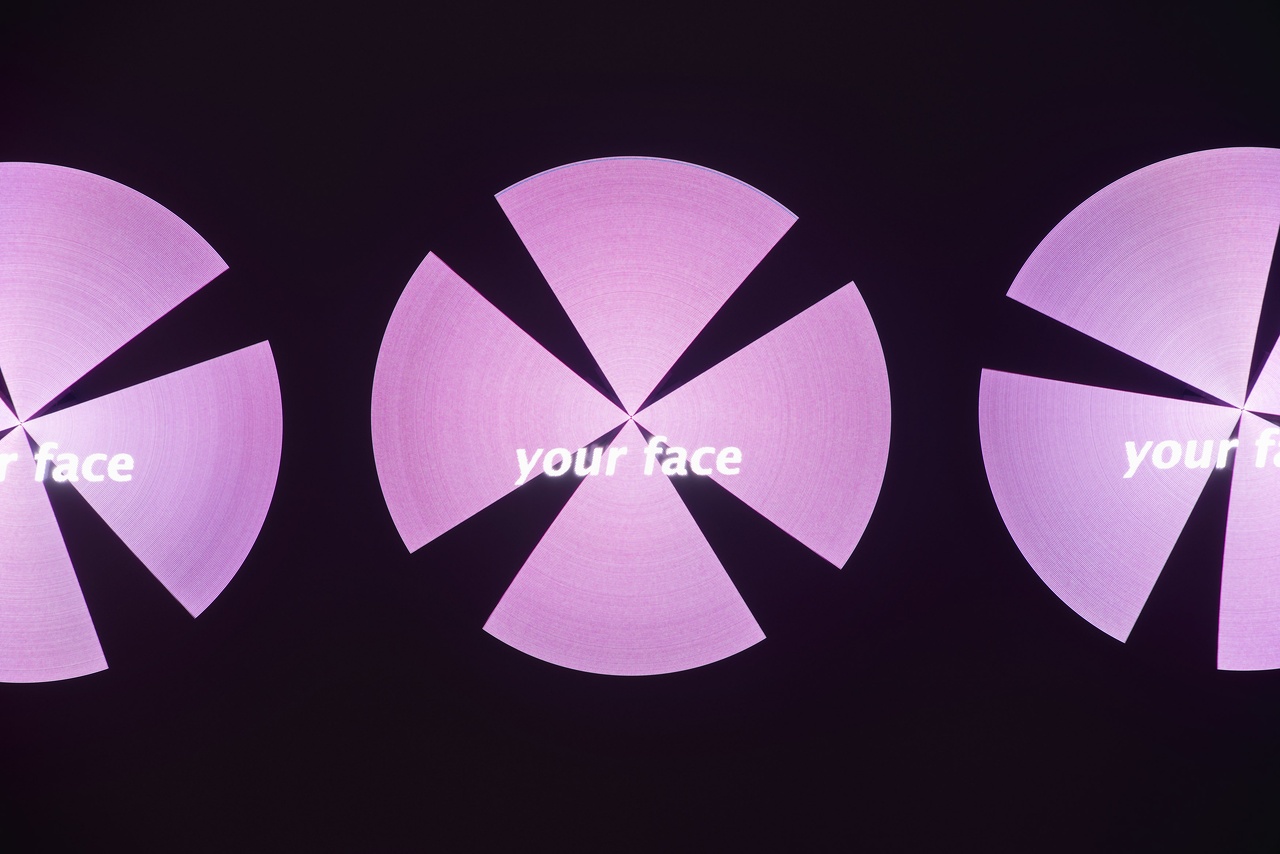
P. Staff, “In Ekstase,” 2023
In the exhibition’s titular artwork, In Ekstase (2023), five synced, motorized fans whirl continuously. The movement of each rotating blade produces synced holographic video-poems across the front of each machine. Words flash, the fans slicing the text staccato, recalling the flicker films of Tony Conrad or Paul Sharits. Staff’s poetry reintroduces eroticism, affairs of heart and body not encountered elsewhere. In the previous work, to name oneself was to give oneself away. In In Ekstase, a new “I” enters center stage, though it is unclear if the narrator is Staff themself, or another fictitious character, the subject of the previous etchings, or if this is a conversation, a love letter, or an internal soliloquy. Like the thrill of the horror flick, there is titillation in fucking in danger – the fans themselves, messengers of this erotic fiction, could chop off a finger – or getting close to, or riding, the edge. Bound to body and bedpost, Staff’s poems read like sweat-drenched fever dreams, or the medicated, horny stupor of sexting from one’s own sickbed.
The orb-fans act as traditional magic lanterns, their repeated motion creating the illusion of the nuclear symbol – “NUCLEAR, YET AGAIN,” the text blinks; radioactive or body-heat imagery is a frequent motif in the artist’s work, as seen in WEED KILLER (2017) and others – as well as the biohazard symbol frequently adopted by HIV-positive communities, before flashing images of drawings and the night sky. The cyborg-animal-human “YOU ARE ALIVE/ I AM DEAD," pharmaceutical-dependent but still primitive, howling, carnal, seeks companionship and relief amidst “GROPING LIMBS.”
In the final chamber of this house of horrors, more tinted lights flank the film installation La Nuite Américaine (The American Night). Employing the old “day for night” film technique from which it (as well as the 1973 Truffaut film) gets its name, La Nuite Américaine is quite literally a blue film, a là Derek Jarman’s Blue (1993) or Maggie Nelson’s 2009 prosaic long-form poem Bluets, cast in an “eternal twilight,” [4] perhaps a visceral nod to the common misnomer about color-blindness in certain non-human animals.
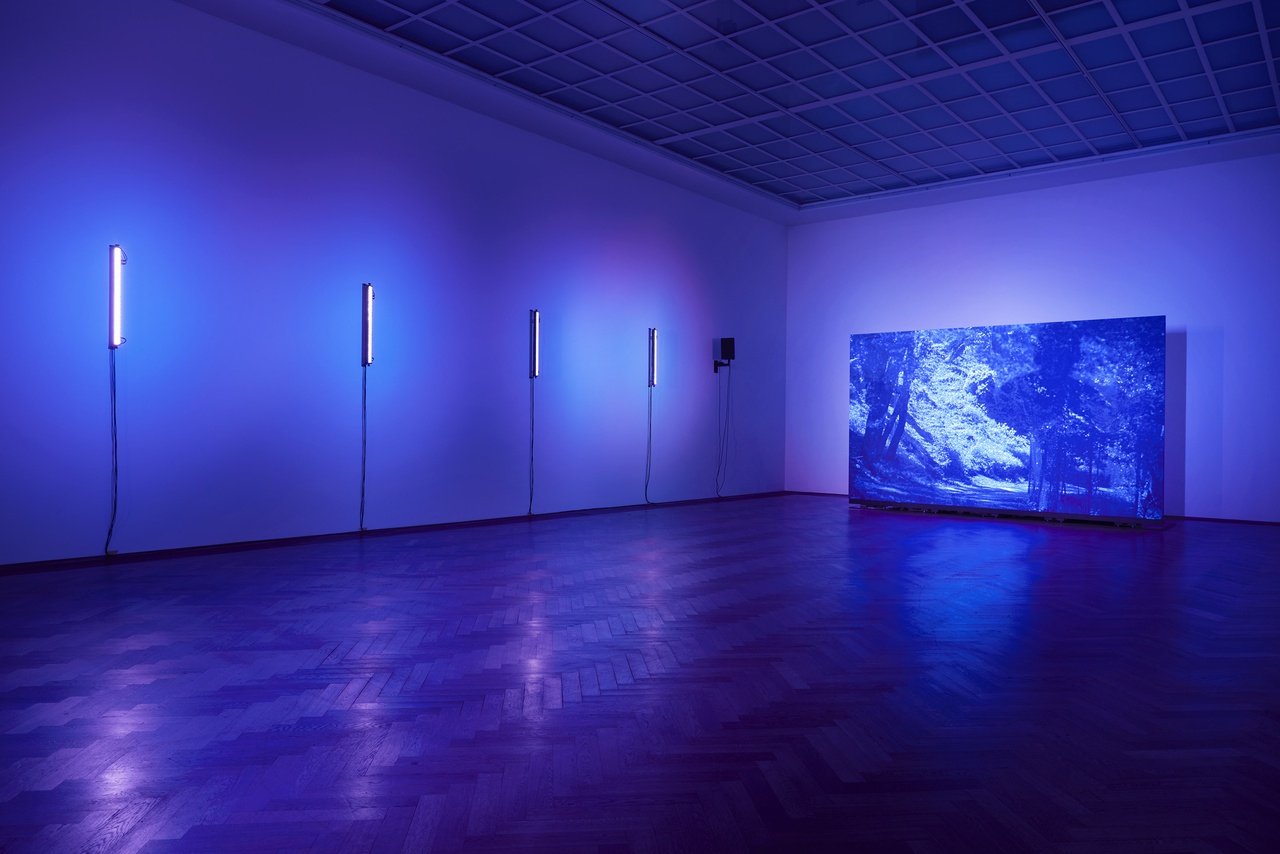
P. Staff, “La Nuit Américaine,” 2023
The pigment psychology of “day for night,” suggests a doubling by way of substitution, an endless, nocturnal end of days under atomic siege. The filter, ubiquitous to special effects programs and social media both, allows the repellant mood lighting to permeate beyond cinematic space. Staff doesn’t try to emulate darkness, but in this queasy, dysmorphic haze everyone is made strange, otherworldly if not othered by a kind of cyanosis, bereft of oxygen.
Guided by a grating industrial soundtrack accented by strings, the film feels diaristic without a need for plot. Life appears slower, stilted, as in a short sequence where the camera, in the style of Michael Snow’s La Région Centrale (1971), bobs and drifts through an empty park and surrounding foliage as if of its own accord. Similar to Snow’s apparatus and the pedigree-less animals of Bloodheads, the subjects of Staff’s film have an inferred sentience but no personhood. This is a film about observation; the camerawork is unusually close for simple surveillance. Nearly all of the portraits, if they can be called that, are shot from the rear, from a human height, as if unknown to the subject. The people are always carrying something: golf clubs, shopping bags, surfboards, trash bags, a child, everyone rushing somewhere with a burden. An especially memorable cameo by Staff themself, in a wetsuit on the beach, is cut mid-action; the edit causes the artist’s body to recoil violently like the hook of a question mark. Seagulls swarm the beach, reminding the human beachcomber of what was destroyed.
The film’s finale is a rapturous crescendo of blinding, strobing white lights burn on either side of the room and behind the LED video wall, beating in time with the score. In the same flickering of In Ekstase, the quick, hallucinatory succession of images – light bulbs, bottles, film cue cigarette burns and disk-like objects – materialize as almost holographic, subliminal portals. As in real life, there is no catharsis, but the montage suggests an ambiguous finality: the score goes guttural, the machine’s pacing grind slackens, all suggesting the final tugs of existence before the butcher’s fatal blow or the subject’s own orgasm, la petite mort. There may not be complete transcendence, or a whole annihilation of the self, but there is a lingering sense of another possible, even temporary, exit, just beyond strictly human comprehension.
“P. Staff: In Ekstase,” Kunsthalle Basel, June 9–September 10, 2023.
Matthew Lax is a Los Angeles–based artist, filmmaker, and writer thinking about animality, queerness, and the limits of language.
Image credit: photo Philipp Hänger / Kunsthalle Basel
Notes
| [1] | The exhibition is underwritten by Yves Saint Laurent, couturier and purveyor of leather goods. |
| [2] | Elena Filipovic, “In Ekstase,” Kunsthalle Basel exhibition text, 6. September 2023. |
| [3] | Sunaura Taylor, “Ableism and Animals,” in Beasts of Burden (New York: The New Press, 2017) 59. |
| [4] | Filipovic, “In Ekstase.” |
